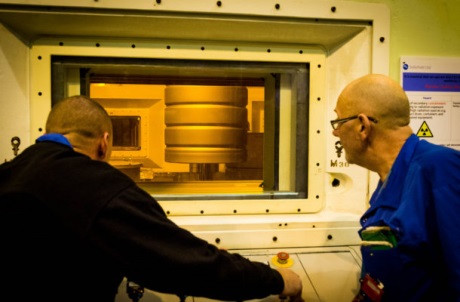Eric Bowe, head of encapsulation plants at Sellafield, said: "This is a great achievement for us; it is the first drum of historic sludge to be encapsulated and stored ready for long-term storage. This is one of the first examples of a legacy facility producing a waste ready for a geological disposal facility - it's a cradle-to-grave solution."
The PFSP pond - built and commissioned between 1948 and 1952 - and the adjoining decanning building provided the storage and cooling facility for irradiated fuel and isotopes from the two Windscale pile reactors. The PFSP processed 2100 tonnes of pile fuel and 300 tonnes of Magnox fuel. The placement of material in the pond - the first nuclear fuel storage pond to be constructed at Sellafield - ceased in the 1970s. Extensive refurbishment and re-equipping took place in the 1980s and decommissioning started in the 1990s.
The subdivided outdoor storage pond is some 100 metres long, 25 metres wide, 7 metres deep and contains over 15 million litres of water, making it the world's largest open-air nuclear storage pond. The PFSP contains skips of irradiated fuel and waste, each skip containing 6-12 cubic metres of material. The removal of sludge - consisting of algae, corrosion products and wind-blown material - that had accumulated in it began in 2008. Fuel removal began in September 2011.
The initial sludge removal involves pumping the material into a purpose-built treatment plant next to the pond, before transfer to the drum filling plant. It will take several years to remove all of the sludge in the pond.
Sellafield Ltd said the sludge removal project is being delivered ten years ahead of schedule and for half the predicted £200 million ($249 million) cost. A ten-year project to dewater the pond will start in 2019, while sludge is still being removed.
Researched and written
by World Nuclear News




